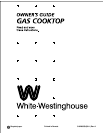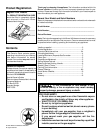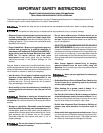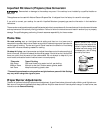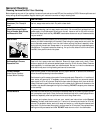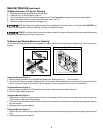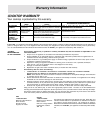
4
Grounding Instructions (electric ignition models only)
IMPORTANT: READ AND SAVE THESE INSTRUCTIONS.
This appliance is equipped with a 3 prong grounding plug for your
protection against shock hazard and should be plugged directly into a properly
grounded receptacle. DO NOT cut or remove the grounding prong from this plug.
For personal safety, this cooktop must be properly grounded. For maximum safety,
the plug must be plugged into a 120V—60 Hz. outlet that is correctly polarized
and properly grounded.
If a two-prong wall receptacle is the only available outlet, it is the personal
responsibility of the consumer to have it replaced with a properly grounded three-
prong wall receptacle installed by a qualified electrician.
DO NOT UNDER ANY CIRCUMSTANCES CUT OR REMOVE THE THIRD ROUND
GROUNDING PRONG FROM THE POWER CORD PLUG. SEE THE INSTALLATION
INSTRUCTIONS PACKAGED WITH THIS COOKTOP FOR COMPLETE INSTALLATION
AND GROUNDING INSTRUCTIONS. DO NOT OPERATE THE COOKTOP USING A
TWO-PRONG ADAPTER OR AN EXTENSION CORD.
Avoid fire hazard or
electrical shock. Do not use an adaptor
plug, an extension cord, or remove
grounding prong from electrical power
cord. Failure to follow this warning can
cause serious injury, fire or death.
Do not, under any
circumstances, cut,
remove, or bypass
the grounding prong.
Power supply cord with
3-prong grounding plug
Grounding
type wall
receptacle
IMPORTANT SAFETY INSTRUCTIONS (continued)
Use Proper Flame Size—Adjust flame size
so it does not extend beyond the edge of the utensil. The
use of undersized utensils will expose a portion of the burner
flame to direct contact and may result in ignition of clothing.
Proper relationship of utensil to flame will also improve
efficiency.
• Use proper pan size—This appliance is equipped with one
or more surface burners of different sizes. Select utensils
having flat bottom large enough to cover the surface burner.
The use of undersized utensils will expose a portion of the
surface burner to direct contact and may result in ignition of
clothing. Proper relationship of utensil to the surface burner
will also improve efficiency.
• Utensil Handles Should Be Turned Inward and Not
Extend Over Adjacent Surface Burners—To reduce the
risk of burns, ignition of flammable materials, and spillage
due to unintentional contact with the utensil, the handle of
the utensil should be positioned so that it is turned inward,
and does not extend over adjacent surface burners.
SAVE THESE INSTRUCTIONS
• Never Leave Surface Burners Unattended at High Heat
Settings—Boilovers cause smoking and greasy spillovers that
may ignite, or a pan that has boiled dry may melt.
• Protective Liners—Do not use aluminum foil to line surface
burner pans. Protective liners or aluminum foil may interfere
with heat and air distribution, and combustion. Damage to the
cooktop or personal injury may result.
• Glazed Cooking Utensils—Only certain types of glass,
glass/ceramic, ceramic, earthenware, or other glazed utensils
are suitable for cooktop service without breaking due to the
sudden change in temperature. Check the manufacturer's
recommendations for cooktop use.
• Do Not Use Decorative Surface Burner Covers. If a burner
is accidentally turned on, the decorative cover will become
hot and possibly melt. You will not be able to see that the
burner is on. Burns will occur if the hot covers are touched.
Damage may also be done to the cooktop or burners because
the covers may cause overheating. Air will be blocked from
the burner and cause combustion problems.



